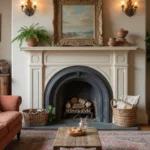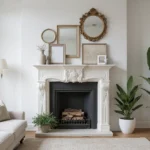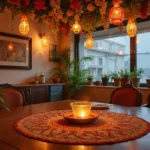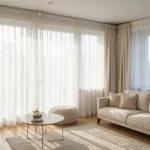Choosing the right paint color for a small bathroom can transform your space from cramped and claustrophobic to bright and inviting. We’ve all stood in tiny bathrooms that felt more like closets than relaxing retreats – and the wrong paint choice often makes this problem worse.
The good news? Strategic color selection can visually expand your bathroom while creating the perfect atmosphere for your daily routines. Whether you’re dealing with windowless powder rooms or compact master bath spaces we’ll show you how the right hues work magic on small square footage.
From light-reflecting neutrals that maximize natural light to bold accent walls that add personality without overwhelming the space we’ve tested the most effective color strategies. These proven paint choices will help you create a bathroom that feels twice its actual size while reflecting your personal style perfectly.
Light and Airy Colors That Make Small Bathrooms Feel Spacious
Light colors serve as natural space enhancers, reflecting available light and creating an illusion of greater square footage. We’ve identified three standout options that consistently deliver impressive visual expansion results.
Classic White for Maximum Light Reflection
White paint remains the gold standard for maximizing light reflection in compact bathroom spaces. This timeless choice bounces natural and artificial light throughout the room, creating an immediate sense of openness that darker colors simply can’t match.
Pure white variants like Benjamin Moore’s Cloud White or Sherwin Williams’ Pure White offer the highest light reflectance values. We recommend these exact shades because they maintain their brightness without appearing cold or sterile. The crisp finish helps bathroom fixtures like mirrors, faucets, and lighting appear more prominent and polished.
Trim work painted in the same white shade creates seamless visual flow from walls to ceiling. This monochromatic approach eliminates visual breaks that can make small spaces feel choppy. Cabinet doors, window frames, and baseboards blend into the overall design when using identical white tones.
Soft Cream for Warmth Without Overwhelming
Cream colors provide gentle warmth while maintaining the light reflecting properties essential for small bathroom success. These subtle off white shades prevent the stark feeling that pure white sometimes creates in windowless or poorly lit spaces.
Farrow & Ball’s Pointing or Benjamin Moore’s Ivory White deliver sophisticated cream tones with undertones that complement various lighting conditions. We’ve found these particular shades work exceptionally well with both warm LED bulbs and natural daylight. The slight yellow undertones add depth without sacrificing the spacious feeling.
Cream backgrounds make white fixtures pop while maintaining visual cohesion throughout the space. Toilets, sinks, and bathtubs appear more defined against cream walls compared to pure white backgrounds. This contrast helps define individual elements without creating harsh visual boundaries.
Pale Gray for Modern Sophistication
Pale gray offers contemporary appeal while delivering the light reflecting benefits crucial for small bathroom design. These sophisticated neutrals provide more visual interest than white options while maintaining their space improving properties.
Sherwin Williams’ Misty or Benjamin Moore’s Classic Gray represent ideal pale gray choices for compact bathrooms. We prefer these exact formulations because they contain cool undertones that prevent the muddy appearance some grays can develop in humid bathroom environments. The subtle blue undertones keep the space feeling fresh and clean.
Gray paint pairs beautifully with both chrome and brushed nickel fixtures commonly found in modern bathroom designs. This versatility allows homeowners to update hardware without repainting walls. The neutral backdrop also accommodates various tile colors and patterns for future renovations.
Cool Tones That Create the Illusion of Space

Cool colors naturally recede from the eye, making walls appear farther away and creating a more spacious feeling in compact bathrooms. These calming hues work exceptionally well in small spaces because they reflect light while maintaining visual depth.
Powder Blue for a Spa-Like Atmosphere
Powder blue transforms cramped bathrooms into tranquil retreats that feel significantly larger than their actual square footage. This soft blue hue creates memories of open seas and endless skies, psychologically expanding the space while promoting relaxation. We’ve seen powder blue work particularly well in bathrooms with limited natural light, where its light-reflecting properties brighten the entire room.
Pairing powder blue with white trim amplifies the spa-like effect, creating clean lines that define the space without overwhelming it. Chrome or brushed nickel fixtures complement this color beautifully, improving the serene atmosphere while maintaining the illusion of spaciousness.
Mint Green for Fresh and Clean Vibes
Mint green brings nature indoors while creating an airy, open feeling that makes small bathrooms appear more expansive. This subtle green tone brightens spaces naturally, reflecting light in a way that enhances both natural and artificial illumination. We recommend mint green for bathrooms that lack windows, as it creates the impression of fresh outdoor air and natural light.
The color pairs exceptionally well with white fixtures and marble accents, creating a fresh aesthetic that feels both modern and timeless. Mint green works particularly effectively in powder rooms where you want maximum visual impact in minimal square footage.
Lavender for Subtle Color Without Closing In
Lavender provides gentle color interest while maintaining the space-expanding benefits of cool tones in compact bathroom designs. This soft purple hue offers a sophisticated alternative to traditional blues and greens, creating a calming atmosphere similar to powder blue without feeling predictable. We’ve found lavender particularly effective in bathrooms with good lighting, where its subtle warmth can shine without overwhelming the space.
The color coordinates beautifully with both warm and cool metallics, allowing for versatile fixture choices that enhance the overall design. Lavender creates a romantic yet serene atmosphere that makes small bathrooms feel like luxurious personal retreats.
Warm Neutrals That Add Comfort to Compact Spaces

Moving beyond cooler tones, warm neutrals strike the perfect balance between cozy intimacy and visual spaciousness in small bathrooms. These colors create an inviting atmosphere while maintaining the light-reflecting properties essential for compact spaces.
Beige for Timeless Elegance
Beige emerges as the quintessential warm neutral that delivers both sophistication and practicality in small bathroom spaces. This classic color reflects light exceptionally well, helping your compact bathroom feel larger and more open than its actual dimensions. We love how beige creates a timeless backdrop that works seamlessly with white fixtures, wood accents, and various design styles from modern minimalism to traditional charm.
Selecting the right beige tone ensures your small bathroom maintains its elegant character without feeling dated or overwhelming. The neutral foundation allows you to experiment with different textures, materials, and accessories while keeping the overall aesthetic balanced and cohesive.
Warm Taupe for Cozy Sophistication
Taupe blends gray and brown undertones to deliver sophisticated warmth that adds depth without shrinking your bathroom space. This versatile neutral creates a cozy atmosphere while maintaining the visual openness essential for compact areas. We recommend pairing warm taupe with metallic finishes like brushed gold or bronze to enhance its sophisticated appeal.
Natural textures complement taupe beautifully, allowing you to incorporate elements like woven baskets, wooden vanities, or stone accents. The color’s inherent complexity adds visual interest without overwhelming the small space, making it an excellent choice for homeowners seeking understated elegance.
Soft Peach for Gentle Warmth
Peach brings subtle warmth and a gentle glow that transforms compact bathrooms into fresh, airy retreats. This warm neutral reads as barely-there color, uplifting your space with its inherent cheerfulness while maintaining the light-reflecting qualities crucial for small areas. We find soft peach particularly effective in creating a spa-like ambiance when paired with white or cream fixtures.
Accenting soft peach walls with natural wood tones or soft pastels enhances the serene atmosphere without compromising the room’s open feel. The color’s gentle nature makes it an ideal choice for creating a welcoming bathroom environment that feels both comfortable and spacious.
Bold Accent Colors for Feature Walls in Small Bathrooms

Strategic color placement can transform small bathrooms into visually spacious retreats. Bold accent walls serve as focal points that draw the eye while maintaining an open atmosphere.
Navy Blue for Dramatic Depth
Navy blue creates a sense of depth that makes small spaces feel larger and more expansive. This sophisticated color works exceptionally well on a single accent wall behind the vanity or bathtub area. Pairing navy with lighter colors prevents the space from feeling overwhelming while maintaining visual interest.
Professional designers recommend using navy blue sparingly to achieve maximum impact. Consider applying this rich color to just one wall while keeping remaining surfaces in crisp whites or soft grays. The contrast between deep navy and lighter tones creates dimension that visually expands the bathroom’s boundaries.
Forest Green for Natural Tranquility
Forest green delivers calming properties that transform compact bathrooms into peaceful sanctuaries. This natural color adds depth and serenity without compromising the room’s open feel. Combining forest green with brass accents and wood tones creates a balanced, spa-like environment.
Natural light enhances forest green’s ability to make spaces feel larger and more connected to the outdoors. We recommend applying this color to a feature wall behind the mirror or shower area. The earthy tone pairs beautifully with white fixtures and creates a sophisticated backdrop for plants and natural textures.
Charcoal Gray for Contemporary Edge
Charcoal gray provides a modern and sleek aesthetic that works particularly well in contemporary bathroom designs. This versatile color offers dramatic impact while maintaining sophistication and elegance. Using charcoal gray on one wall or as a ceiling color creates striking visual effects.
Contemporary bathrooms benefit from charcoal gray’s ability to ground the space while reflecting subtle light. The color works exceptionally well with metallic finishes like brushed nickel or matte black hardware. Strategic placement on a single accent wall prevents the color from overwhelming the compact space while delivering maximum style impact.
Paint Finishes That Work Best in Small Bathroom Spaces

We’ve covered color selection, but the finish you choose is equally important for maximizing space and functionality. Paint finishes directly impact how light reflects in your bathroom and how well the surface withstands moisture.
Semi-Gloss for Easy Cleaning and Light Reflection
Semi-gloss stands out as the most practical choice for small bathroom spaces. This finish excels at reflecting light, which naturally makes your compact bathroom appear larger and brighter. We recommend semi-gloss because it withstands moisture exceptionally well, making it ideal for high-humidity environments like powder rooms and master baths.
Cleaning becomes effortless with semi-gloss surfaces since you can easily wipe down walls without damaging the paint. The durability factor matters significantly in small spaces where every surface gets frequent use. Your walls maintain their fresh appearance longer when protected by this resilient finish.
Light reflection properties of semi-gloss work particularly well with the whites, soft blues, and subtle grays we discussed earlier. The glossy surface bounces natural and artificial light around your bathroom, creating that coveted spacious feeling.
Satin Finish for Balanced Durability and Appearance
Satin offers the perfect middle ground between functionality and aesthetics for bathroom walls. This finish provides a soft sheen that’s easier to clean than matte or eggshell options while maintaining a more subtle appearance than semi-gloss. We find satin particularly suitable for bathrooms with moderate moisture levels.
Appearance wise, satin creates a sophisticated look that works beautifully with warm neutrals like beige and soft peach. The finish adds depth to your chosen paint color without creating harsh reflections that might make a small space feel clinical. Your bathroom maintains an inviting atmosphere while still benefiting from practical cleaning properties.
Moisture resistance in satin finish makes it a reliable choice for guest bathrooms or half baths where humidity levels fluctuate. The balance between durability and visual appeal ensures your small bathroom looks polished while standing up to daily use.
Color Combinations That Maximize Small Bathroom Potential

Strategic color pairings create visual depth while maintaining the spacious feel we’ve established with individual color choices. Light wall colors paired with crisp white ceilings or trim enhance brightness and perceived size throughout your bathroom.
Monochromatic Schemes for Seamless Flow
Monochromatic palettes using varying shades of a single color create the most cohesive and uncluttered appearance in small bathrooms. This approach visually expands your room by minimizing color contrast and distractions that can make spaces feel cramped.
Soft gray monochrome schemes work exceptionally well, combining light gray walls with darker gray accents on vanity areas or wainscoting. We recommend starting with a pale gray like Benjamin Moore’s Classic Gray and adding depth through medium gray towels or accessories.
Blue monochromatic combinations transform compact bathrooms into serene retreats using powder blue walls with navy blue accents sparingly applied to cabinet hardware or picture frames. This creates visual interest without overwhelming your limited square footage.
Green monochrome palettes establish spa-like ambiance through mint green walls complemented by sage green bath linens or plant accents. The seamless color flow makes your bathroom boundaries feel less defined and more expansive.
Two-Tone Approaches for Visual Interest
Two-tone combinations add visual depth and architectural interest while maintaining the open feel essential for small bathrooms. Light walls paired with slightly darker accent walls create focal points that draw the eye strategically through your space.
Soft blue walls with white woodwork provide classic contrast that highlights trim details and makes ceilings appear taller. This combination works particularly well in powder rooms where we can use bolder blue shades without overwhelming daily users.
Light walls with darker accent ceilings create dramatic height illusion when executed properly with colors like charcoal gray or deep navy. We keep walls in bright whites or pale grays to maintain light reflection while the darker ceiling adds unexpected sophistication.
Cream walls with warm taupe wainscoting establish elegant two-tone schemes that feel both cozy and spacious. The lighter upper portion reflects maximum light while the darker lower section provides grounding without visual weight.
Bold accent walls in jewel tones can be incorporated sparingly for contrast using saturated colors like emerald or sapphire on single feature walls. We balance these dramatic choices with white or light neutral surrounding walls to prevent color overwhelm in your compact space.
Common Paint Color Mistakes to Avoid in Small Bathrooms

While we’ve covered the best color choices for small bathrooms, it’s equally important to understand which paint decisions can work against your space. These common mistakes can make your compact bathroom feel even smaller and more confined.
Dark Colors That Make Spaces Feel Cramped
Dark colors absorb light rather than reflect it, creating an immediate sense of enclosure in small bathrooms. Deep browns, saturated grays, and overly intense hues can visually shrink your space by up to 20%, making even moderately sized bathrooms feel claustrophobic. We’ve seen countless homeowners choose rich, dramatic colors without considering how they’ll interact with limited natural light.
Navy blues and charcoal grays work best as accent walls rather than dominant colors throughout the entire space. Forest greens and burgundy shades can overwhelm small bathrooms unless you’re using strategic lighting and white fixtures to create contrast. Black paint should be reserved for very exact design elements like trim or vanity cabinets, not entire walls.
Flat finishes in dark colors compound this problem by creating light-absorbing surfaces that make spaces feel heavy and closed in. Semi-gloss or satin finishes in lighter colors reflect significantly more light than their darker counterparts.
High-Contrast Combinations That Break Up Space
High-contrast color combinations can visually fracture your bathroom, making it appear choppy and disconnected rather than cohesive. Black and white stripes or bold geometric patterns draw the eye to exact areas, breaking up the visual flow that makes spaces feel larger. We recommend avoiding sharp contrasts between walls, ceilings, and trim when working with limited square footage.
Dark accent walls paired with bright white surroundings can create jarring transitions that emphasize the room’s boundaries. Bold patterns like large-scale florals or geometric designs fragment the space visually, making it feel busier and more confined. Contrasting tile and paint colors that compete for attention create visual chaos rather than the serene atmosphere that enhances perceived spaciousness.
Two-tone paint schemes work best when the colors are within 2-3 shades of each other on the color wheel. Monochromatic approaches using varying intensities of the same color family create better flow and continuity than dramatic contrasts.
Conclusion
We’ve covered the essential strategies for transforming your small bathroom with the perfect paint color. The right choice can make your space feel twice as large while reflecting your personal style.
Remember that light-reflecting colors remain your best allies in compact bathrooms. Whether you choose classic whites soft neutrals or strategic accent walls the key is maximizing natural and artificial light.
Don’t forget about paint finishes – they’re just as important as color selection. Semi-gloss and satin finishes will keep your walls looking fresh while withstanding moisture and daily use.
With these proven techniques you’re ready to create a bathroom that feels spacious welcoming and beautifully designed regardless of its actual square footage.
Frequently Asked Questions
What are the best paint colors for small bathrooms?
Light colors are ideal for small bathrooms as they reflect light and create spaciousness. Classic white shades like Benjamin Moore’s Cloud White and Sherwin Williams’ Pure White are top choices. Soft cream colors such as Farrow & Ball’s Pointing add warmth, while pale grays like Sherwin Williams’ Misty offer modern sophistication. These colors maximize light reflection and help define fixtures.
Can I use bold colors in a small bathroom?
Yes, bold colors work well as accent walls in small bathrooms. Navy blue creates dramatic depth, forest green provides calming sanctuary vibes, and charcoal gray adds contemporary sophistication. Use these colors on a single feature wall while keeping other walls light to maintain an open atmosphere and prevent overwhelming the space.
What paint finish should I choose for small bathrooms?
Semi-gloss is the most practical choice for small bathrooms due to excellent light reflection and moisture resistance. It’s easy to clean and maintains a fresh appearance in high-humidity environments. Satin finish offers a balanced alternative with soft sheen and easier cleaning than matte, making it suitable for moderate moisture levels.
Do cool tones make small bathrooms look bigger?
Yes, cool tones create the illusion of expanded space in compact bathrooms. Powder blue transforms cramped areas into tranquil retreats, mint green offers freshness for windowless spaces, and lavender maintains calming atmospheres. These colors pair beautifully with white fixtures and metallic accents while promoting spaciousness.
What color mistakes should I avoid in small bathrooms?
Avoid dark colors that absorb light, such as deep browns and saturated grays, which make spaces feel cramped. Don’t use high-contrast combinations or bold patterns that create visual chaos. Sharp contrasts can visually fracture the space. For two-tone schemes, choose colors within 2-3 shades of each other for better flow.
Can warm colors work in small bathrooms?
Absolutely! Warm neutrals like beige, warm taupe, and soft peach add comfort while maintaining spaciousness. Beige creates elegant backdrops that work with various styles, warm taupe offers sophisticated depth, and soft peach provides spa-like ambiance. These colors maintain light-reflecting properties essential for small spaces.
How do I create effective color combinations for small bathrooms?
Pair light wall colors with crisp white ceilings or trim to enhance brightness. Use monochromatic schemes with varying shades of one color for cohesive, uncluttered appearances. Try two-tone approaches with light walls and darker accent walls for focal points. Balance bold accent walls with lighter surrounding colors.















